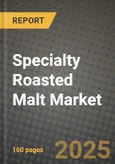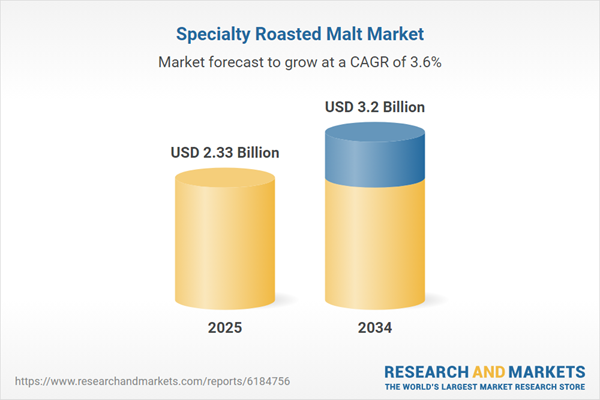Specialty Roasted Malt Market
The Specialty Roasted Malt market comprises drum-roasted, kilned, and caramel/crystal malts engineered to deliver color, body, foam persistence, and complex flavor notes - caramel/toffee, biscuit, nutty, coffee, cocoa, and light smoke - across beer, craft spirits, malt-based RTDs, bakery/snacking, and flavor extracts. Core end-uses remain craft and premium beer styles (stout/porter, brown/amber ales, Schwarzbier, black IPA, red lagers), with growing adoption in low/no-alcohol recipes to restore mouthfeel and aroma, as well as in whisk(e)y and specialty bread/crackers for Maillard-driven depth. Latest trends include precision color/roast profiling (EBC/SRM tight tolerances), high-conversion caramel malts for brewhouse efficiency, gluten-free bases (sorghum, buckwheat) with roasted adjuncts, drum/fluidized-bed technologies for uniformity, and “clean-label” flavor builds that reduce reliance on extracts. Demand is reinforced by premiumization in on-trade, seasonal/limited releases, pastry stouts and dessert-inspired variants, and the rise of local/craft maltsters marketing terroir and traceability. Key drivers include the continued global spread of craft and better-beer segments, reformulation for alcohol-reduced and sessionable styles, and brand differentiation through color and sensory storytelling. The competitive landscape features integrated global malt groups with broad specialty portfolios, regional malt houses focused on heritage barleys and estate supply, and craft maltsters offering bespoke roasts and short lead times. Differentiation hinges on batch-to-batch consistency, moisture and friability control, husk integrity (for lautering), color stability in package, and technical support on grist composition and mash profiles. Sustainability - regenerative barley, energy-efficient kilns, electrification, and by-product valorization - has become a purchasing criterion for breweries and co-manufacturers.Specialty Roasted Malt Market Key Insights
- Precision roast control wins. Tight EBC/SRM targets and low variation across lots reduce reformulation risk; sensors and thermal modeling in drum roasters improve repeatability for flagship SKUs.
- Caramel & crystal as workhorses. Medium crystal (40-80L) lifts body/foam and balances hop bitterness; higher caramelization supports pastry stout and amber lagers without astringency when paired with base malts.
- Chocolate/black malts for aroma, not just color. De-bittered and husk-managed variants deliver cocoa/espresso notes with lower polyphenol harshness, enabling higher inclusion in dark lagers and nitro stouts.
- Low/no-alcohol reformulation tailwind. Roasted malts rebuild mouthfeel and flavor density lost in arrested fermentation or dealcoholization, reducing reliance on additives.
- Adjunct diversity broadens the palette. Roasted rye, wheat, and oats add spice/silk and improve head retention; gluten-free roasted grains expand access for specialty producers.
- Brewhouse efficiency matters. High-conversion caramel malts and optimized crush profiles protect lauter speed; maltsters provide diastatic guidance to avoid stuck mashes in dark grists.
- Shelf life and packaging control. Oxygen and moisture management (nitrogen-flushed bags, lined totes) preserve aroma and color; freshness dating and COA transparency are buying defaults.
- Terroir and traceability sell. Named barley varieties and local grower programs support brand stories and premium pricing, with QR-enabled batch provenance common in craft channels.
- Sustainability becomes a spec. Energy intensity per tonne, kiln electrification, renewable sourcing, and spent-grain valorization influence RFP scoring alongside price and sensory.
- Technical services differentiate. Grist calculators, color prediction, and pilot-scale collaboration shorten development cycles and de-risk seasonal and limited-release programs.
Specialty Roasted Malt Market Reginal Analysis
North America
Demand is anchored by a deep craft ecosystem and robust seasonal programs (porters/stouts in winter, red/amber and dark lagers year-round). Breweries seek consistent COAs, fast replenishment, and local-story malts from regional craft maltsters. No- and low-alcohol reformulation boosts use of caramel/chocolate malts for body. Sustainability metrics (regenerative barley, rTPA energy) influence procurement; contract pricing smooths barley volatility.Europe
Long heritage in dark lagers and ales sustains steady specialty usage; de-bittered black and chocolate malts are popular for balance in continental lagers. Large brewers value tight color tolerance and long-run consistency; regional malt houses emphasize protected varieties and PDO-style narratives. Energy costs accelerate kiln efficiency upgrades and electrification. Export-oriented craft scenes in UK, Germany, Nordics drive pastry stout and barrel-aged variants.Asia-Pacific
Rapid growth in urban craft hubs and premium imports lifts specialty demand, particularly for approachable amber/red ales and dessert-leaning stouts. Brewers prioritize technical support, smaller MOQs, and stable color in warm chains. Australia/New Zealand highlight local barleys and roasted wheat/rye; Japan/Korea emphasize precise roast profiles and smooth bitterness; India and ASEAN focus on flexible supply and education.Middle East & Africa
Premium on-trade venues and tourism corridors expand demand for imported and local craft dark styles; non-alcoholic malt beverages/RTDs leverage roasted notes for complexity. Logistics and shelf-life control are critical - nitrogen-flushed packaging and climate-resilient storage mitigate aroma fade. Emerging micro-maltings and bakery users create adjacent opportunities for roasted flours and toppings.South & Central America
Growing craft communities in Brazil, Mexico, Argentina, and Chile drive adoption of caramel and chocolate malts for stouts/porters and dark lagers. Price sensitivity favors blended specialty programs and regional milling. Warm-chain realities heighten focus on freshness and moisture control. Local barley development and partnerships with universities support variety trials and sensory mapping.Specialty Roasted Malt Market Segmentation
By Source
- Barley
- Wheat
- Rye
By Application
- Brewing
- Distilling
- Non-alcoholic malted beverages
- Bakery
Key Market players
Briess Malt & Ingredients Company, IREKS GmbH, Boortmalt (Axereal Group), Malteurop Groupe, Simpsons Malt Limited, GrainCorp Ltd., Rahr Corporation, Muntons plc, Castle Malting, Viking Malt AB, Weyermann Specialty Malts, Bar Malt India Pvt Ltd., Gladfield Malting Company, Canada Malting Co., Thomas Fawcett & Sons Ltd.Specialty Roasted Malt Market Analytics
The report employs rigorous tools, including Porter’s Five Forces, value chain mapping, and scenario-based modelling, to assess supply-demand dynamics. Cross-sector influences from parent, derived, and substitute markets are evaluated to identify risks and opportunities. Trade and pricing analytics provide an up-to-date view of international flows, including leading exporters, importers, and regional price trends.Macroeconomic indicators, policy frameworks such as carbon pricing and energy security strategies, and evolving consumer behaviour are considered in forecasting scenarios. Recent deal flows, partnerships, and technology innovations are incorporated to assess their impact on future market performance.
Specialty Roasted Malt Market Competitive Intelligence
The competitive landscape is mapped through proprietary frameworks, profiling leading companies with details on business models, product portfolios, financial performance, and strategic initiatives. Key developments such as mergers & acquisitions, technology collaborations, investment inflows, and regional expansions are analyzed for their competitive impact. The report also identifies emerging players and innovative startups contributing to market disruption.Regional insights highlight the most promising investment destinations, regulatory landscapes, and evolving partnerships across energy and industrial corridors.
Countries Covered
- North America - Specialty Roasted Malt market data and outlook to 2034
- United States
- Canada
- Mexico
- Europe - Specialty Roasted Malt market data and outlook to 2034
- Germany
- United Kingdom
- France
- Italy
- Spain
- BeNeLux
- Russia
- Sweden
- Asia-Pacific - Specialty Roasted Malt market data and outlook to 2034
- China
- Japan
- India
- South Korea
- Australia
- Indonesia
- Malaysia
- Vietnam
- Middle East and Africa - Specialty Roasted Malt market data and outlook to 2034
- Saudi Arabia
- South Africa
- Iran
- UAE
- Egypt
- South and Central America - Specialty Roasted Malt market data and outlook to 2034
- Brazil
- Argentina
- Chile
- Peru
Research Methodology
This study combines primary inputs from industry experts across the Specialty Roasted Malt value chain with secondary data from associations, government publications, trade databases, and company disclosures. Proprietary modeling techniques, including data triangulation, statistical correlation, and scenario planning, are applied to deliver reliable market sizing and forecasting.Key Questions Addressed
- What is the current and forecast market size of the Specialty Roasted Malt industry at global, regional, and country levels?
- Which types, applications, and technologies present the highest growth potential?
- How are supply chains adapting to geopolitical and economic shocks?
- What role do policy frameworks, trade flows, and sustainability targets play in shaping demand?
- Who are the leading players, and how are their strategies evolving in the face of global uncertainty?
- Which regional “hotspots” and customer segments will outpace the market, and what go-to-market and partnership models best support entry and expansion?
- Where are the most investable opportunities - across technology roadmaps, sustainability-linked innovation, and M&A - and what is the best segment to invest over the next 3-5 years?
Your Key Takeaways from the Specialty Roasted Malt Market Report
- Global Specialty Roasted Malt market size and growth projections (CAGR), 2024-2034
- Impact of Russia-Ukraine, Israel-Palestine, and Hamas conflicts on Specialty Roasted Malt trade, costs, and supply chains
- Specialty Roasted Malt market size, share, and outlook across 5 regions and 27 countries, 2023-2034
- Specialty Roasted Malt market size, CAGR, and market share of key products, applications, and end-user verticals, 2023-2034
- Short- and long-term Specialty Roasted Malt market trends, drivers, restraints, and opportunities
- Porter’s Five Forces analysis, technological developments, and Specialty Roasted Malt supply chain analysis
- Specialty Roasted Malt trade analysis, Specialty Roasted Malt market price analysis, and Specialty Roasted Malt supply/demand dynamics
- Profiles of 5 leading companies - overview, key strategies, financials, and products
- Latest Specialty Roasted Malt market news and developments
Additional Support
With the purchase of this report, you will receive:- An updated PDF report and an MS Excel data workbook containing all market tables and figures for easy analysis.
- 7-day post-sale analyst support for clarifications and in-scope supplementary data, ensuring the deliverable aligns precisely with your requirements.
- Complimentary report update to incorporate the latest available data and the impact of recent market developments.
This product will be delivered within 1-3 business days.
Table of Contents
Companies Mentioned
- Briess Malt & Ingredients Company
- IREKS GmbH
- Boortmalt (Axereal Group)
- Malteurop Groupe
- Simpsons Malt Limited
- GrainCorp Ltd.
- Rahr Corporation
- Muntons PLC
- Castle Malting
- Viking Malt AB
- Weyermann Specialty Malts
- Bar Malt India Pvt Ltd.
- Gladfield Malting Company
- Canada Malting Co.
- Thomas Fawcett & Sons Ltd.
Table Information
| Report Attribute | Details |
|---|---|
| No. of Pages | 160 |
| Published | November 2025 |
| Forecast Period | 2025 - 2034 |
| Estimated Market Value ( USD | $ 2.33 Billion |
| Forecasted Market Value ( USD | $ 3.2 Billion |
| Compound Annual Growth Rate | 3.6% |
| Regions Covered | Global |
| No. of Companies Mentioned | 15 |









